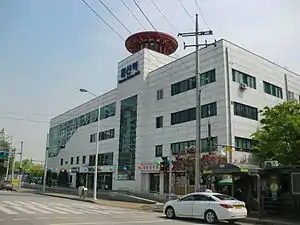Munsan Station
Munsan Station is a railway station on the Gyeongui–Jungang Line. It is notable for being the closest station on the Seoul Metropolitan Subway to the border with North Korea that is open for passenger service, only a few kilometers away.[2]
| ||||||||||||||||||||||||||||||||||||||||
|---|---|---|---|---|---|---|---|---|---|---|---|---|---|---|---|---|---|---|---|---|---|---|---|---|---|---|---|---|---|---|---|---|---|---|---|---|---|---|---|---|
 | ||||||||||||||||||||||||||||||||||||||||
| Korean name | ||||||||||||||||||||||||||||||||||||||||
| Hangul | ||||||||||||||||||||||||||||||||||||||||
| Hanja | ||||||||||||||||||||||||||||||||||||||||
| Revised Romanization | Munsannyeok | |||||||||||||||||||||||||||||||||||||||
| McCune–Reischauer | Munsannyŏk | |||||||||||||||||||||||||||||||||||||||
| General information | ||||||||||||||||||||||||||||||||||||||||
| Location | 17-550 Munsan-ri Munsan-eup, Paju-si Gyeonggi-do[1] | |||||||||||||||||||||||||||||||||||||||
| Coordinates | 37°51′16″N 126°47′17″E | |||||||||||||||||||||||||||||||||||||||
| Operated by | ||||||||||||||||||||||||||||||||||||||||
| Line(s) | Gyeongui–Jungang Line | |||||||||||||||||||||||||||||||||||||||
| Platforms | 3 | |||||||||||||||||||||||||||||||||||||||
| Tracks | 6 | |||||||||||||||||||||||||||||||||||||||
| Bus routes | 9710 9710-1 7700 11 11-1-1 11-2 22 22-1 22-2 92 92-1 93 93-1 93-2 93-3 93-4 93-5 93-6 93-7 93-8 93-9 93-10 93-11 93-12 93-13 93-14 95 021 051A 051A(행복) 051B 051B(행복) 053 053-1 054-1 054-2 054-3 054-4 054-5 054-6 054-7 054-8 058A 058A(임진각) 058B 058B(임진각) | |||||||||||||||||||||||||||||||||||||||
| Construction | ||||||||||||||||||||||||||||||||||||||||
| Structure type | Aboveground | |||||||||||||||||||||||||||||||||||||||
| History | ||||||||||||||||||||||||||||||||||||||||
| Opened | April 4, 1906[1] | |||||||||||||||||||||||||||||||||||||||
| ||||||||||||||||||||||||||||||||||||||||
History
On March 18, 2007, a train from Munsan Station entered North Korea for the first time since 1951 under South Korean Unification Minister Lee Jae-joung.[3] Members of the opposition Grand National Party criticized the event as a political stunt.[4]
Services
As a regular railway station it is an interim stop between Dorasan Station in the Demilitarised Zone and Seoul Station.[5] The tourist train between Seoul and the DMZ Border is currently not in operation, due to concerns about the spread of the outbreak of African swine fever.[6]
The Gyeongui–Jungang Line (Munsan–Imjingang) extension opened on March 28, 2020.[7]
Station layout
| L2 Platforms |
Platform 6 | DMZ Train toward Dorasan (Uncheon) → |
| Island platform, doors will open on the left, right | ||
| Platform 5 | ← DMZ Train toward Seoul (Neunggok) | |
| Platform 4 | Gyeongui–Jungang Line Alighting Passengers Only → Gyeongui–Jungang Line toward Imjingang (Uncheon) → | |
| Island platform, doors will open on the left, right | ||
| Platform 3 | Gyeongui–Jungang Line Alighting Passengers Only → Gyeongui–Jungang Line toward Imjingang (Uncheon) → | |
| Platform 2 | ← Gyeongui–Jungang Line toward Jipyeong (Paju) | |
| Island platform, doors will open on the left, right | ||
| Platform 1 | ← Gyeongui–Jungang Line toward Jipyeong (Paju) | |
| L1 Concourse |
Lobby | Customer Service, Shops, Vending machines, ATMs |
| G | Street level | Exit |
References
- 문산역 (in Korean). Doosan Encyclopedia. Retrieved 2015-08-27.
- "Subway". Visit Seoul. Archived from the original on 2014-08-08. Retrieved 2015-08-27.
- Sang-Hun, Choe (2007-05-18). "North and South Send Trains Across the Korean Frontier". The New York Times. ISSN 0362-4331. Retrieved 2023-07-11.
- Sang-Hun, Choe (2007-05-17). "Korean Train Crossing Seen as Sign of Progress". The New York Times. ISSN 0362-4331. Retrieved 2023-07-11.
- "Train to Dorasan Station in DMZ resumes". Korea JoongAng Daily. 2014-05-13. Retrieved 2015-08-27.
- ""[공지] DMZ-train(용산↔도라산) 운행조정 알림"" [DMZ-train (Yongsan↔Dorasan) operation adjustment notice] (in Korean). October 2, 2019. Retrieved October 1, 2019.
- "(pt40)경의.중앙선 임진강역 문산행 열차 시간표" [(pt40) Timetable for trains to Munsan at Imjingang Station on the Gyeongui-Jungang Line] (in Korean). March 28, 2020.
